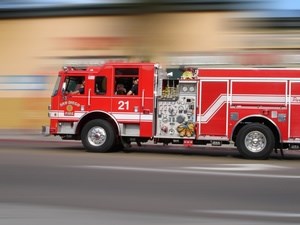
High-Rise Fireground Experiment Results
Overall Time to Task Completion and Crew Size
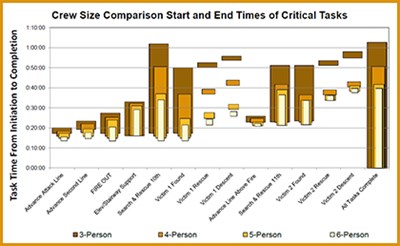
These graphs show average times for each critical task by crew size. Percentage calculations for all the charts were based on the overall time from detection of the incident to the completion of all on-scene tasks. Overall scene time is the time that firefighters are engaged in tasks on the scene, unavailable for dispatch to other incidents. The times noted do not include some tasks such as salvage, overhaul and secondary search of the structure as these were not included in the field experiments.
Note: Time to detection, call processing time, and travel time may vary across jurisdictions. The times used in this report are considered conservative.
Advance Attack Line
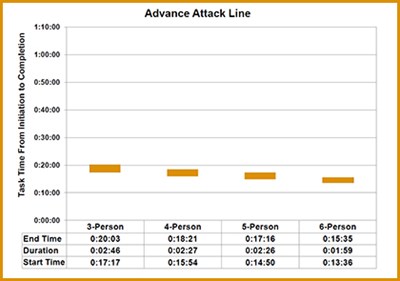
Putting water on the fire is one of the most important tasks on the fireground. Before water can be put on a fire however, a hose line must be stretched from the standpipe in the stairwell to the compartment where the fire is burning. This chart shows the measured interval from the start to the end of the task Advance Attack Line. The time differences increased with increasing crew size.
From the initiation of on-scene firefighting activities, 4-person crews were 1 minute 42 seconds (8.5%) faster than 3-person crews to stretch the hose line. Five-person crews were 2 minutes 47 seconds (13.9%) faster than 3-person crews. The most notable comparison is between 6-person crews and 3-person crews. The 6-person crews were 4 minutes 28 seconds (22.3%) faster in task completion time.
Advance Second Line
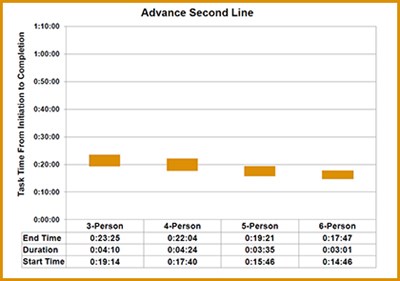
The size of the fire required two 2½ inch lines to fully suppress, therefore a second hose line had to be advanced from the standpipe in the stairwell to the fire. This chart shows the measured interval from the start of the task Advance Second Line to the end of this task.
From the initiation of on-scene firefighting activities, 5-person crews were 4 minutes 4 seconds (17.4%) faster than 3-person crews and 2 minutes 43 seconds (12.3%) faster than 4-person crews to stretch the second line. Finally, the most notable comparison was between 6-person crews and 3-person crews. The 6-person crews were faster by 5 minutes 38 seconds (24.1%) in task completion time.
Fire Out
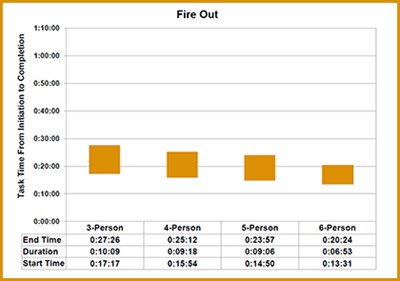
Extinguishing the fire is critical to reducing risk to both firefighters entering the structure and to occupants. Fire out, in the study, was defined as having both the attack line and the second hose line in place.
As shown in this chart, the 4-person crews were 2 minutes 14 seconds (8.1%) faster in the fire out time compared to 3-person crews. The 5-person crews were 1 minute 15 seconds (5.0%) faster than 4-person crews and 3 minutes 29 seconds (12.7%) faster than 3-person crews. The 6-person crews finished 7 minutes 2 seconds (25.6%) faster than the 3-person crews.
Search and Rescue 10th Floor
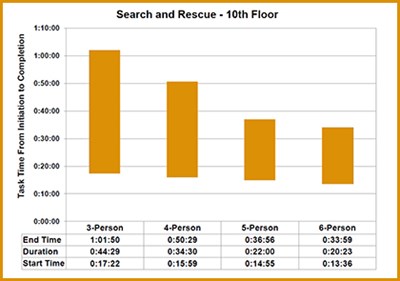
The fire floor in the experiments measured 30,000 sq ft (2,800 sq m) and contained 96 cubicles. This chart summarizes the amount of time that crews took to start and complete the search on the fire floor.
The 4-person crew started the search 1 minute 23 seconds (7.8%) faster than the 3-person crew and completed the search and rescue 11 minutes 21 seconds (18.4%) faster than the 3-person crews. The 5-person crews started the search 1 minute 4 seconds (6.7 %) faster than the 4-person crews and 2 minutes 27 seconds (14.1%) faster than the 3-person crew. Additionally, 5-person crews completed the search faster than the 4- and 3-person crews by 13 minutes 34 seconds (26.8%) and 24 minutes 55 seconds (40.3%) respectively. Six-person crews had the best times, starting the search 1 minute 19 seconds (8.8%) faster and completing the search 2 minutes 57 seconds faster than 5-person crews (8.0%). The greatest difference in search times was between 6- and 3-person crews. Six-person crews started the search on the fire floor 3 minutes 46 seconds (21.7%) faster and completed the search 27 minutes 51 seconds (45.0%) faster than the 3-person crews.
Victim #1 Found
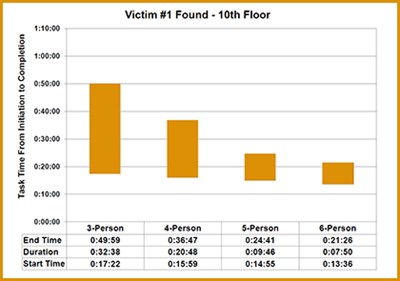
There was a single victim located on the fire floor that was found and rescued by all crews. This chart shows the time taken by crews to locate the victim on the fire floor.
A 5-person crew operating in the high-rise structure located the victim 25 minutes 18 seconds (50.6%) faster than a 3-person crew and 12 minutes 7 seconds (32.9%) faster than a 4-person crew. A 6-person crew located the victim on the fire floor 28 minutes 33 seconds (57.1%) faster than the 3-person crew, 15 minutes 21 seconds (41.7%) faster than the 4-person crew, and 3 minutes 14 seconds (13.2%) faster than a 5-person crew.
Victim #1 Rescue
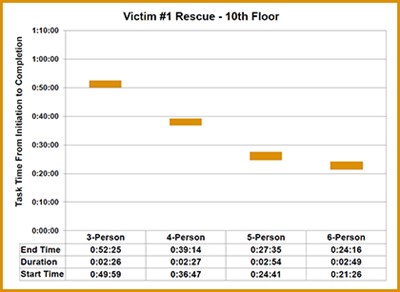
Since the experiment protocol dictated that each victim be rescued by two firefighters, one at the shoulders and one at the legs, the duration of the victim rescue varies only slightly as seen in this chart. However, the start and end time of victim rescue is significantly different between crews.
Four-person crews removed the victim from the Immediately Dangerous to Life and Health (IDLH) environment 13 minutes 11 seconds (25.1%) faster than a 3-person crew. Likewise, 5-person crews were able to remove the victim from the fire environment 11 minutes 39 seconds (29.7%) faster than the 4-person crews while 6-person crews removed the victim from the environment 14 minutes 58 seconds (38.1%) faster than the 4-person crews and 3 minutes 19 seconds (12.0%) faster than the 5-person crews.
Victim #1 Descent
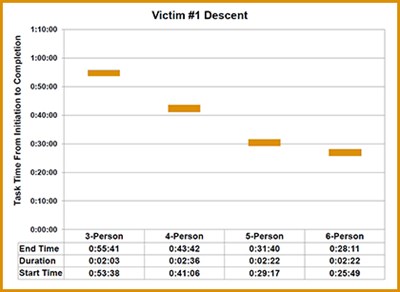
Experiment protocols required that an EMS crew of two carry the victim out of the building. Each crew was to descend via stairs or elevator depending on the scenario being tested, so duration times did not vary greatly between overall crew sizes studied as shown in the chart. The start and end times of this task did vary.
Four-person crews were able to facilitate the victim descent and exit from the building 11 minutes 59 seconds (21.5%) faster than 3-person crews. Five-person crews were able to facilitate victim descent 11 minutes 39 seconds (27.5%) faster than 4-person crews and 24 minutes 1 seconds (43.1%) faster than 3-person crews while 6-person crews were 3 minutes and 19 seconds faster than 5-person crews (11.0%). Additionally, victim descent occurred 4 minutes 42 seconds more quickly for crews using the elevator rather than the stairs.
Advance Line Above Fire
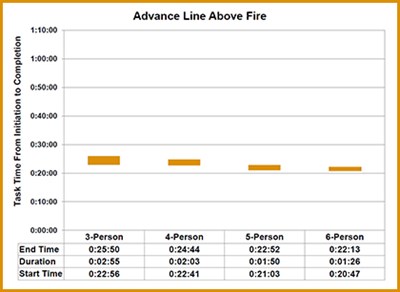
In a high-rise structure, it is essential to place a hose line on the floor above the fire floor to fight potential vertical fire spread. This chart shows the measured interval from the start of the task Advance Line Above Fire to the end of this task.
Comparing crew sizes, 5-person crews were 2 minutes 58 seconds (11.5%) faster than a 3-person crew to complete the same task. The most notable comparison was between 6-person crews and 3-person crews. The 6-persons crews were 3 minutes 37 seconds (14.0%) faster in task completion time.
Search and Rescue 11th Floor
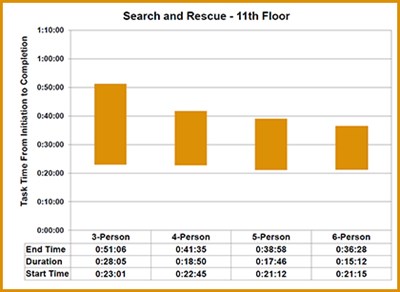
The floor above the fire was separated into a number of conference rooms and offices that had to be searched by each crew. The area of the floor measured 30,000 sq ft (2,800 sq m). This chart summarizes the times that crews took to start and complete the search on the floor above the fire.
During the experiments, the 4-person crews completed the search 9 minutes 31 seconds (18.6%) faster than the 3-person crews. Meanwhile, the 5-person crews started a primary search/rescue 1 minute 34 seconds (6.8%) faster than the 4-person crews and completed the search 2 minutes 37 seconds (6.3%) faster than the 4-person crews. In the same structure, the 6-person crews also started the search 1 minute 30 seconds (6.6%) faster than the 4-person crews but completed the search 5 minutes 8 seconds (12.3%) faster than the 4-person crews.
Victim #2 Found
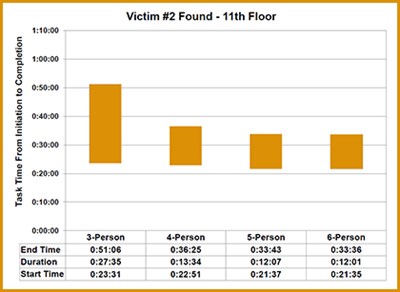
In addition to the victim on the fire floor, a second victim was located on the floor above the fire. Each crew operating on this floor was tasked with locating and rescuing the victim. This chart shows the times when crews located the victim on the floor above the fire.
A 5-person crew operating in the high-rise structure located the second victim 17 minutes 23 seconds (34%) faster than a 3-person crew and 2 minutes 41 seconds (7.4%) faster than a 4-person crew. A 6-person crew located the second victim on the floor above the fire 2 minutes 48 seconds (7.7%) faster than the 4-person crew.
Victim #2 Rescue
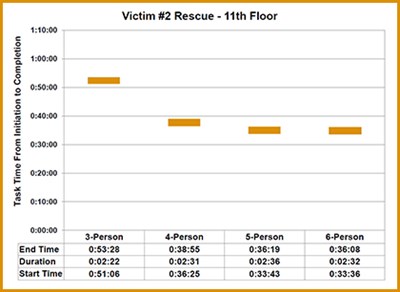
Since the experiment protocol dictated that each victim be rescued by two firefighters, one at the shoulders and one at the legs, the duration of the rescue of Victim #2 varies only slightly by crew size as seen in this chart. However, the start and end times of victim rescue is significantly different between crews due to performance on previous tasks.
Four-person crews removed Victim #2 from the IDLH environment 14 minutes 33 seconds (27.2%) faster than a 3-person crew. Five-person crews were able to remove Victim #2 from the fire environment 17 minutes 9 seconds faster (32.1 %) than 3-person crews and 2 minutes 36 seconds faster than the 4-person crews (6.7%). Similarly, the 6-person crews rescued the victim 2 minutes 48 seconds (7.1%) faster than 4-person crews.
Victim #2 Descent
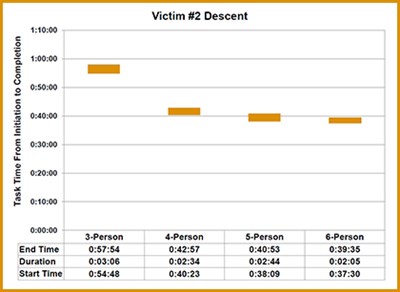
As with Victim #1, experiment protocols required that an EMS crew of two carry the victim out of the building. Each crew was to descend via stairs or elevator depending on the scenario being tested, so duration times did not vary greatly between overall crew sizes studied as seen in this chart. The start and end times of this task did vary.
Five-person crews were able to facilitate the victim descent 2 minutes 4 seconds (4.8%) faster than 4-person crews and 17 minutes 1 second (29.4%) faster than 3-person crews. Six-person crews were able to facilitate victim descent 3 minutes 21 seconds (7.8%) faster than 4-person crews. Additionally, victim descent occurred nearly 6 minutes more quickly for crews using the elevator rather than stairs.
Simultaneous Operations by Crew Size

The 38 fireground tasks included in the experiments were completed by all crews regardless of crew size. However, as on an actual fireground, assignments of crews and the tactics used on each task varied based on the availability of firefighters to complete the task. For example, search patterns used on the fire floor and floor above the fire were dependent on the number of firefighters available on the crew assigned to complete the task. These charts show how tasks were simultaneously or sequentially performed based on the number of firefighters available on scene.
Note: A = Ambulance, E = Engine, T= Truck
Combining Crew Size, Ascent Mode and Alarm Size
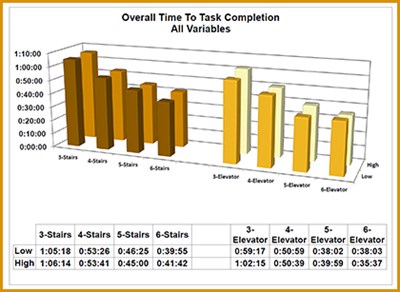
This chart represents a visual comparison of All Tasks Complete for all three study variables: crew size, ascent mode (stairs vs. elevators), and alarm size.
Combining Alarm and Crew Size
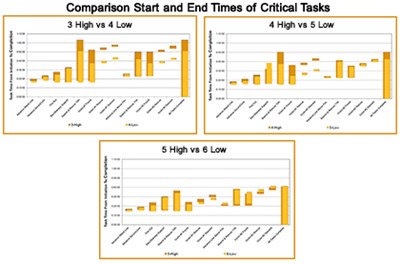
Given the findings from the crew size analysis that adding one or two firefighters to a crew could, on average, achieve substantial task time decreases, a logical question is whether the meaningful benefits of a higher crew size could be realized by implementing a higher alarm response at a smaller crew size (e.g., high/4 compared to low/5). The hope might be that a high response with lower crew size would yield similar results in task timing to that of a low response with higher crew size.
The analysis shows that statistically significant differences in begin times occurred for a low alarm response with 4 or 5 crew size compared to high response with crew sizes of 3 and 4, respectively. It is noteworthy that this pattern does not hold for low response with a crew size of 6 compared to high response with a crew size of 5. The observed differences in begin times were significantly higher for Primary Search of Floor 11 and Advance Line Above Fire.
These charts also provide a graphical summary of findings for tasks deemed critical for duration times. Although less than a third of the comparisons were statistically significant, when they occurred, they tended to be prominent.
Finally, these charts present critical task contrasts of low alarm size to that of a high alarm size with one less crew on staff. Generally, for critical task end times, reductions were most pronounced when comparing low/4 to high/3, followed by low/5 compared to high/4. The low/6 combination featured the smallest reductions compared to the high/5.